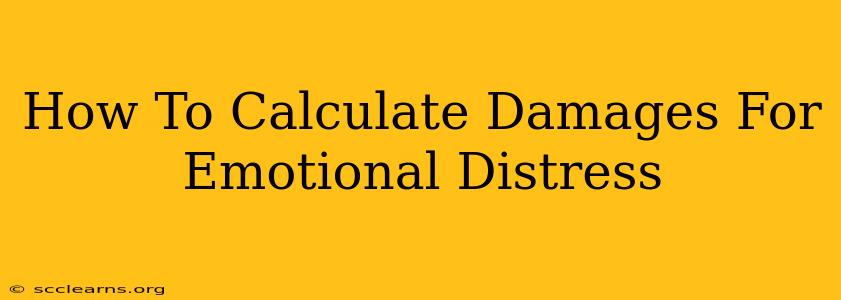Emotional distress, the anguish and suffering caused by another's actions, can leave deep scars. If you've experienced this due to negligence or intentional wrongdoing, you might be entitled to compensation. However, calculating damages for emotional distress is complex and varies significantly by jurisdiction and the specifics of your case. This guide will illuminate the process, helping you understand the factors involved.
Understanding Emotional Distress Damages
Before diving into calculations, it's crucial to understand the types of emotional distress recognized by the law:
-
Negligent Infliction of Emotional Distress (NIED): This occurs when someone's carelessness causes you significant emotional harm. For example, witnessing a loved one's injury due to another's negligence could lead to NIED. Proving this often requires demonstrating a direct causal link between the negligence and your emotional distress.
-
Intentional Infliction of Emotional Distress (IIED): This involves intentional acts designed to cause severe emotional distress. Examples include harassment, stalking, or extreme workplace bullying. The threshold for proving IIED is higher, demanding evidence of outrageous conduct causing severe emotional harm.
Key Factors Affecting Damage Calculation
Several factors influence the calculation of damages for emotional distress:
1. Severity and Duration of Distress:
The intensity and longevity of your emotional suffering significantly impact the compensation. Mild anxiety lasting a few days will result in a far lower award than severe trauma lasting years. Detailed documentation, including therapy records, medical reports, and personal journals, is crucial here. Strong evidence of the emotional impact is key to a successful claim.
2. Nature of the Emotional Distress:
Different forms of emotional distress carry varying weight. Diagnosable conditions like anxiety disorders, depression, or PTSD carry more weight than general feelings of sadness or upset. Medical evaluations and professional diagnoses are vital in supporting your claim.
3. Medical Treatment and Expenses:
Any medical expenses incurred due to the emotional distress, including therapy, medication, and hospitalization, are directly compensable. Keep meticulous records of all receipts and invoices.
4. Lost Wages and Productivity:
If your emotional distress impacted your ability to work, you can claim lost wages and reduced earning capacity. This requires documentation of missed workdays, reduced productivity, and potential future earnings lost due to the emotional harm. Detailed payroll records and employment documentation are essential.
5. Pre-existing Conditions:
Pre-existing mental health conditions can affect the damage calculation. The defendant may argue that your current emotional distress stems from pre-existing issues, not their actions. Clearly demonstrating the causal link between the defendant's actions and the aggravation of your existing condition is crucial.
Methods of Calculating Damages
There's no single formula for calculating damages. However, some common approaches include:
-
Per Diem Damages: This involves assigning a daily or weekly monetary value to your suffering. This method requires meticulous documentation illustrating the ongoing impact on your life.
-
Multiplier Method: This involves multiplying a figure representing past medical expenses and lost wages by a specific multiplier to account for future pain, suffering, and emotional distress. The multiplier is often determined based on the severity of your injuries and other factors.
-
Comparison to Similar Cases: Your attorney might compare your case to similar cases that have been successfully litigated. This provides a benchmark for potential compensation.
Seeking Professional Help
Navigating emotional distress claims can be complex. Consult with an experienced personal injury attorney who specializes in this area. They can guide you through the process, gather necessary evidence, and represent your interests effectively. An experienced lawyer will help determine the appropriate calculation method for your unique circumstances and advocate for your best possible outcome.
Remember: This information is for educational purposes and should not be considered legal advice. Always seek professional legal counsel for your specific situation.

